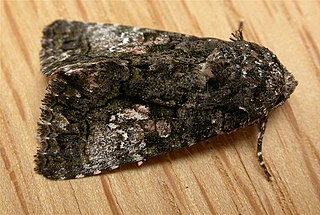
Aedia leucomelas, the eastern alchymist, sweet potato leaf worm or sorcerer, is a moth of the family Noctuidae. It is found in large parts of the world, ranging from Europe all over Asia up to Japan and some African countries. The subspecies Aedia leucomelas acronyctoides is found in Australia.
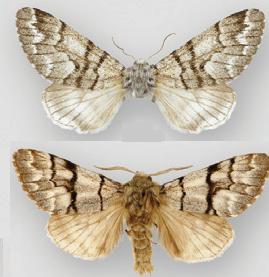
Panthea furcilla is a species of moth of the family Noctuidae. It is found across the boreal forest region of Canada west to the Rocky Mountains, and in the eastern parts of the United States, from Maine to Florida, west to Texas, north to Indiana and Ohio.

Abagrotis alternata, the greater red dart or mottled gray cutworm, is a moth of the family Noctuidae. The species was first described by Augustus Radcliffe Grote in 1865. It is found in eastern North America, from New Brunswick west across southern Canada to western Alberta, south to Arizona, New Mexico and the Gulf of Mexico.

Catocala junctura, the joined underwing or Stretch's underwing, is a moth in the family Erebidae. The species was first described by Francis Walker in 1858. It is found throughout temperate North America, ranging from New York and Pennsylvania west to Montana, Colorado, Oklahoma, Arizona, and into Texas, and north to southern Illinois, extreme southern Alberta and Saskatchewan; it has also been recorded west of the Rocky Mountains from California and south-eastern British Columbia. It is typically found near water, where the food plants of its caterpillar larvae grow plentifully.
Acronicta vulpina, the vulpina dagger moth or miller dagger moth, is a moth of the family Noctuidae. The species was first described by Augustus Radcliffe Grote in 1883. It is found in North America from New York and Newfoundland west to central British Columbia, south to Colorado.
Autographa flagellum, the silver whip, is a moth of the family Noctuidae. The species was first described by Francis Walker in 1858. It is found in North America from Newfoundland west across southern Canada to south-eastern British Columbia, south in the east to Maine, Michigan and Wisconsin. There are isolated reports from further south.

Panthea gigantea is a moth of the family Noctuidae. It is found throughout much of the warmer and drier regions of western North America from south-central British Columbia, south to the state of Durango in Mexico and from the Black Hills of South Dakota, western Nebraska and the Texas Panhandle west to Washington, Oregon and the coast of California.

Panthea is a genus of the owlet moth family, Noctuidae. The word Panthea is from Greek, meaning "of all gods".

Panthea apanthea is a moth of the family Noctuidae. The species is found in three areas of the south-western United States, Coconino County and Apache County in Arizona, and El Paso County in east-central Colorado.
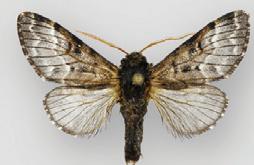
Panthea reducta is a moth of the family Noctuidae. It has been collected at an elevation of 1,800 m (5,900 ft) in a Hispaniolan pine forest in Sierra de Bahoruco National Park in the Dominican Republic.

Panthea judyae is a moth of the family Noctuidae. It has been collected in the Mogollon Mountains and Big Burro Mountains of south-western New Mexico, the Huachuca Mountains of south-eastern Arizona, and the Sierra Madre Occidental of northern Mexico, at elevations of 1800–2400 m.
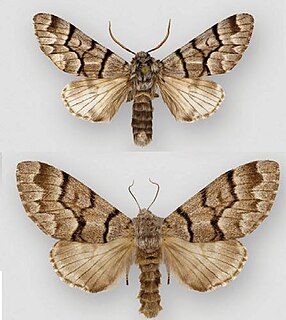
Panthea guatemala is a moth of the family Noctuidae. It has been collected in the mountains of Guatemala and the states of Oaxaca and Chiapas in adjacent southern Mexico at elevations of 1580–1850 m.

Panthea greyi is a moth of the family Noctuidae. It has been collected in the mountains of Arizona, New Mexico, Colorado and southern Utah, at elevations of 1524–2545 m.
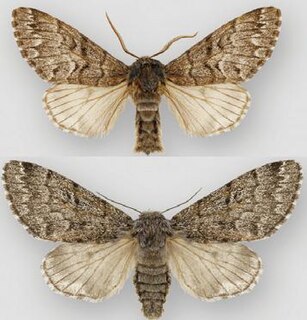
Panthea virginarius, the Cascades panthea, is a moth of the family Noctuidae. It is mainly found west and north of the Great Basin, from the coast of southern California northward to the Queen Charlotte Islands of British Columbia and the Alaskan Panhandle, eastward to central California, northern Nevada, Idaho, north-western Wyoming, western Montana, and south-western Alberta. A disjunct population is found in the Cypress Hills of Alberta and Saskatchewan.
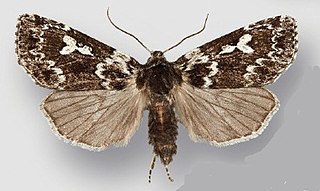
Xestia perquiritata, the boomerang dart, is a moth of the family Noctuidae. The species was first described by Herbert Knowles Morrison in 1874. It is found across North America from Newfoundland, Labrador and northern New England, west to central Yukon, British Columbia and Washington. There are several disjunct populations, including one in the Great Smoky Mountains National Park and the Rocky Mountains in Colorado and a coastal bog in central Oregon.
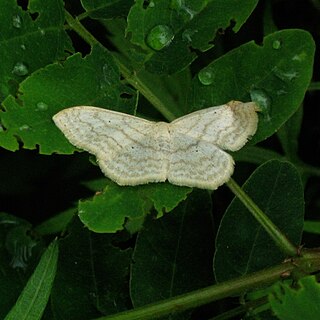
Idaea tacturata, the dot-lined wave moth, is a moth of the family Geometridae. The species was first described by Francis Walker in 1861. It is found in the US from Virginia to Florida, west to south-eastern coastal Texas.

Caradrina multifera, the speckled rustic moth, is a moth of the family Noctuidae. The species was first described by Francis Walker in 1857. It is found in North America from Newfoundland to North Carolina and Tennessee and west to Minnesota and Manitoba. It is also present in British Columbia and Washington.

Dioryctria reniculelloides, the spruce coneworm, is a moth of the family Pyralidae. The species was first described by Akira Mutuura and Eugene G. Munroe in 1973. It is found from Nova Scotia to Alaska, south in the east to New York, and south in the west to California and New Mexico. It was recorded from China in 2009. Occasionally abundant, often in conjunction with epidemics of the spruce budworm, the spruce coneworm occurs through most or all of the range of spruce in North America, feeding on new foliage and cones of spruce, and often balsam fir. When abundant, it can be a serious pest "particularly on white spruce".
Black moth or Black Moth can refer to:

Proteuxoa comma is a species of moth in the family Noctuidae. It is endemic to New Zealand. It can be found in the lower half of the North Island and throughout the South Island, although it appears to be more frequent on the eastern side of these islands, and also is present in Stewart Island. P. comma is very similar in appearance to P. tetronycha but can be distinguished as it is a larger moth with slightly different colouration on, as well as shape of, its forewings. This species pupates in the soil. The adult moths are on the wing from December to April. P. comma may possibly be declining in population and as at 2017 a reassessment of its conservation status is regarded as being needed.













